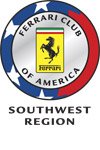
Getting Ready for Monterey
With Monterey and the FCA National Meet just around the corner many Ferrari owners are putting the finishing touches on restoration efforts in the hopes of taking home an award. With that in mind, below is information adapted from an article by Ed Gilbertson in Prancing Horse #90 that might provide some insight into how FCA judging works, what's necessary to win, and what isn't.As Ferrari owners and enthusiasts we all have a responsibility to help preserve the history of the marque. There is no better way to do this than to maintain the originality and condition of the cars and drive them as they were meant to be driven. The Concours, done properly, is a measure of how successful we are in our efforts.
The judging guidelines have been developed with the assistance and support of the National Advisory Council for Preservation of the Ferrari Automobile (NAC/PFA) They are based on actual experience over a number of years and reflect input from many judges and entrants having an interest in consistent and objective standards for showing and judging the Ferrari. The following guidelines, while by no means a complete treatise on the subject, should provide enough basic information to give the reader a good idea what to expect at the FCA Annual Meeting and other Concours events using the NAC/PFA procedures.
- Each Ferrari entered for judging is expected to be fully operational and driven onto the show field for placement in the designated class. Cars are to be shown fully assembled. That is, all parts such as bumpers, top, etc. are to be attached to the vehicle in the original position. The car should be presented as it was delivered by the factory. Since originality is the key focus of the Concours, spyder conversions and unauthorized rebodies are not eligible for judging. Also, new cars are not normally judged since a class of such vehicles is basically a cosmetics contest.
- The owner is to be present with the vehicle during the judging. If, for good reason, the owner cannot be available, a single individual may be designated by the owner to show the car during the class judging process. In presenting the car for judging, all panels and doors should be closed, windows should be in the closed position, and applicable tools and manuals should be displayed either in the trunk compartment or on the ground behind the vehicle. All extraneous material should be removed from the car and placed out of sight before judging commences.
- Each vehicle entered for judging will be evaluated by a three person judging team. One of the judges will be designated the Chief Class Judge and will be responsible for introductions, team coordination, and submission of the class results to the Chief Judge and the Head Scorekeeper. Each judge will have a separate set of forms and will be responsible for evaluating one of the following categories: exterior, interior, or engine/chassis. Each component in each category will be judged for both originality and condition. Factory options are considered original, after-market options are not original and points will be deducted for such items.
- Each car is assumed to have a perfect score of 100 points at the start of judging. As each component is judged, deductions of 0 to 5 points will be made as appropriate for faults in originality and general condition. In addition to point deductions for under-restoration, points will be deducted for over-restoration, such as extravagant paint, extra plating, and enhanced finishes. Such over-statements detract from the originality and the basic goal of preservation. I have to admit that it is a complete turnoff for me when I see a car wrapped like a Christmas package arrive for a show. Brought out of its protective shell, the car is sometimes fitted with a brand new set of wheels to replace the other brand new wheels whose tires might have picked up grass stains as the car was moved onto<
